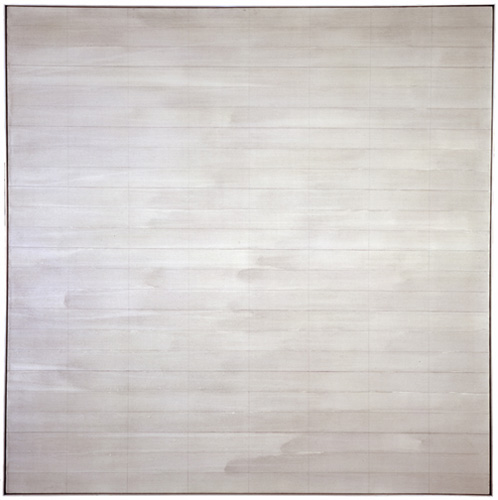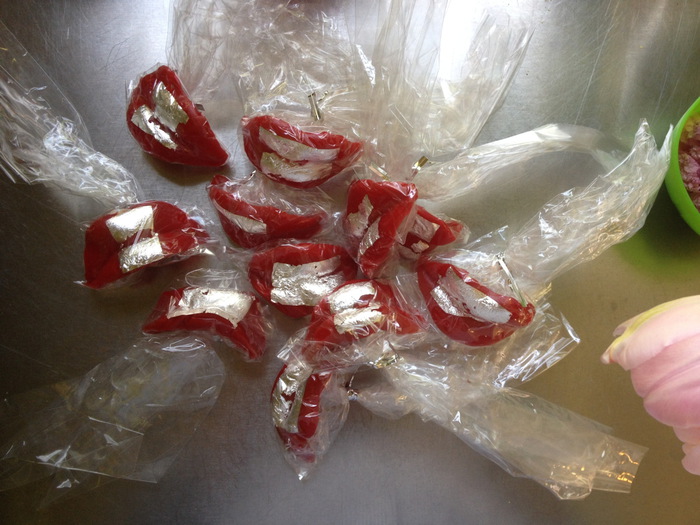
This post is for the archivists out there, and is inspired by putting away sweaters and Paul Soulellis’s Rhizome post about zip files.
In September 2010 I wrote about what I called the Gala-as-Art Movement.
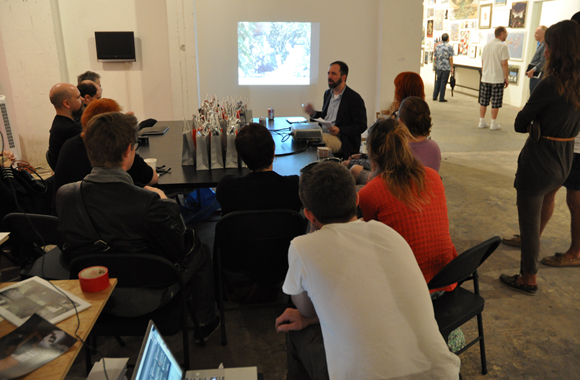
installation image of Untitled (#rank Gift Bag) via hyperallergic
In December I presented an expanded history of Relational Aesthetics For The Rich at #rank, Jen Dalton and William Powhida’s Art Basel Miami Beach follow-up to #class. Both #rank and #class were done for Ed Winkleman Gallery. #rank was actually part of Seven, the independent satellite exhibition. I later put a poorly edited audio/slideshow version of the Gala As Art on Vimeo. I expect I will edit the transcript and images into book form as well.
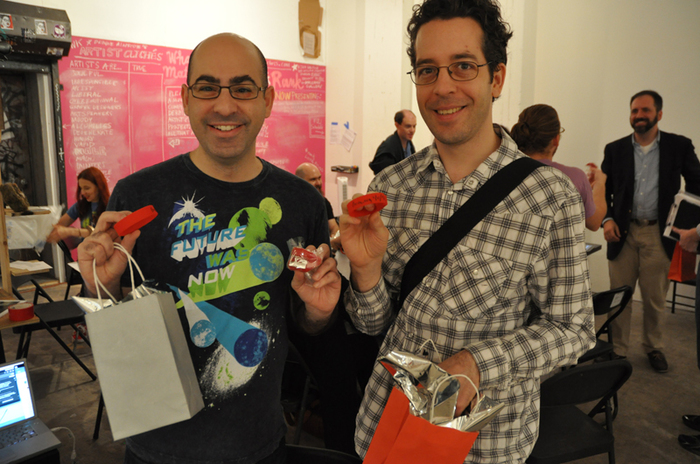
I decided at the last minute to create an edition for the #rank event, and that the most appropriate form was a gift bag. I was reminded of how, staying true to its gift bag nature, I had not explained the edition, and had not identified it as an edition per se, even though, if you looked, there were clues. Up until now, this Hyperallergic photo of Veken and Jesse Lambert was the only public documentation of this edition.
Then I was putting some sweaters away this weekend, and I found a bag of leftover parts from editions that had gone uncollected after the event. I will now describe the edition, its elements, and its development.
The impetus for an edition was the gold-leaf chocolate lips dessert edition created by Kreemart for Marina Abramovic’s The Artist Is Present after-gala. I put edible silver leaf on red wax lips, and repackaged them. I also bought edible gold leaf, which, having never bought it before, I found unexpectedly expensive. I tested with the silver and found it satisfying, but I did not return the gold.
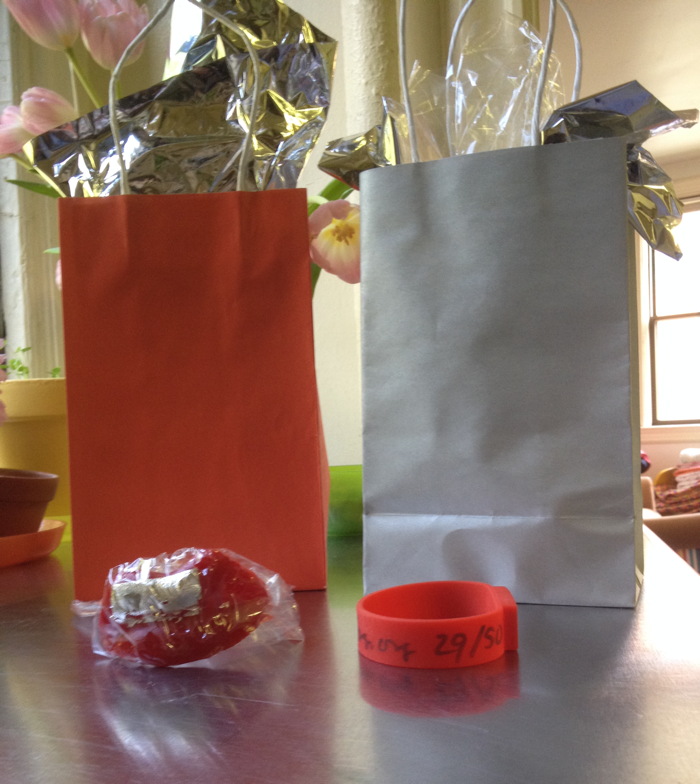
The lips alone were insufficient, however, and thus the gift bag idea was reached. The color theme came from the silvered lips, which, as the colors of a Diet Coke can, also evoked the autobiographical. I wanted to add a tchotchke, like a LIVESTRONG bracelet, but the lead time was killing me.
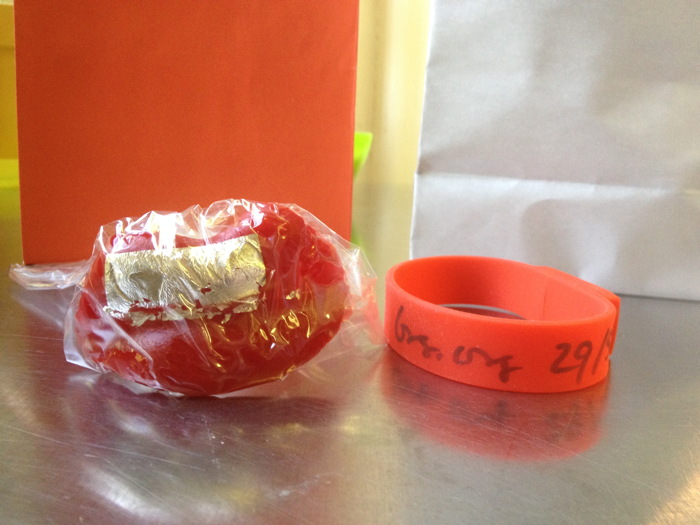
I decided to publish the supporting media for the project the way Doug Aitken had made an artist book for his MOCA Happening. I thought of burning a bunch of DVDs, but I didn’t want to get all designy. I thought of a customized USB stick, but again, I had too little lead time. These two objects merged into one, though, when I found a silicone bracelet with USB memory embedded. I signed and numbered the band, and named each drive with its edition number. I remember after the event, hearing people not realizing it was a USB stick, and thinking oh well, no one gets it, and no one will ever see it.

In the few minutes between finding these USB bracelets and opening one again, I imagined publishing the whole thing as an e-book, or a PDF. I’d remembered more texts and fewer videos. Which is why Soulellis’s zip file art publishing stuck in my mind. But that’s the beauty of zip-based publishing: it can take anything. And so they’re here, as Gala-as-Art_Gift_Bag.zip. The contents are as seen in the screenshot above.
The bag also contained a card, in the format of a gala invitation, in which all the artists mentioned were listed as benefit committee members. I have not found the leftover stack of these cards, which were hastily and unsatisfyingly produced on the ground at some Kinko’s in Miami Beach. But when I do, I will document it here.
The bags are similarly suboptimal, looking nothing like their pictures in the Oriental Trading Co. catalog. The silver mylar, however, is just right, and should be properly considered by future historians of the exhibition history of satelloons.
Untitled (#rank Gift Bag) is the second time I’ve introduced an artwork in the context of a presentation. Instead of site-specific, they’re situation-specific. In each case, I took Cary Leibowitz’s practice to heart, and signed something “so you won’t throw it away.” And yet even considering fluxus and James Lee Byars and the stuff I’ve got socked away in storage, I expect that few if any examples of either piece have survived in the wild. I also expect that it doesn’t matter.
So while this doesn’t reconstitute the works, and I’m not inclined to do anything with the leftovers, when it comes to ever discussing the works and their experience, I have changed my position on whether you really had to be there.
Gala-as-Art_Gift_Bag.zip [dropbox greg.org, 254mb]
Previously: An Incomplete History of The Gala-as-Art Movement [greg.org]
The Gala As Art As Slideshow [ibid.]
The Gala As Art, greg.org, at #rank 2010 [vimeo]
Why Ed Winkleman did #rank at the Seven Miami Art Fair [hyperallergic]
Category: production notes
Destroyed Agnes Martin Paintings
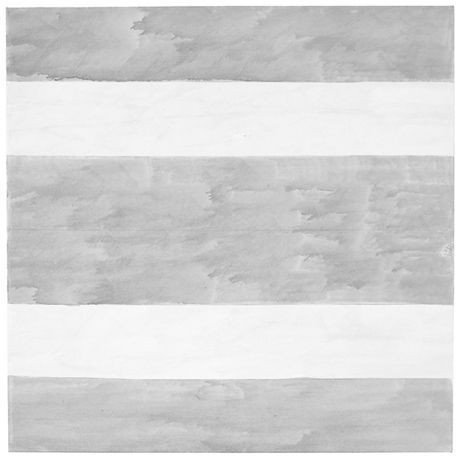
Untitled, 2004, Agnes Martin’s last painting. Image via Phaidon
The visits that maybe stick in the mind are the ones where she would show me four versions of a single painting and she’d say to me. ‘I think this is the best one, what do you think?’ Invariably there was so little difference between them, it was so hard to say, they were all really beautiful. And then she’d say OK we’re gonna keep that one and we’re going to cut up the others. And I would help with a knife slice up the paintings. Those are the studio visits that I think are the sharpest, helping her destroy the work.
What goes through your mind the first time you hear something like that?
It’s her work, and I’m a co-worker in the art field. . . but yeah. It is brutal. I was there at the end of her life and she said ‘go down to the studio, there are three paintings. Hanging on the wall is the one I want to keep, I want you to destroy the other two.’ So I went down to the studio. The two paintings she wanted me to destroy were magnificent – absolutely perfect. The one on the wall was a very stormy painting, unlike anything that she had made since the 60s. I certainly didn’t want to destroy those two spectacular paintings but I did. I sliced them to ribbons and put them in the trash. When I came back. She said, ‘did you do it?’ I said, ‘I did it.’ And that was that. Our last conversation.
Arne Glimcher, in a Q&A published last month by Phaidon.
The Q&A is timed to the publication of Agnes Martin: Paintings, Writings, Remembrances by Arne Glimcher, an extraordinary collection of Martin’s writings and correspondence, many works, and Glimcher’s own snapshots and notes. He would take extensive notes during his studio visits with Martin in New Mexico, and then transcribe them on the plane home.
He expands on Martin’s last request to destroy some of her work in March 2004:
A mystique exists that Agnes painted very few works but in actuality, she painted almost daily when inspired and that was with some frequency. However, only a relatively small amount of works exist from such a long and productive life because she destroyed most of the works she produced. Probably no artist has ever been a better editor than Agnes Martin. The rejected paintings were shredded with a mat knife. As she grew older, during the last few years, she enlisted the help of friends (myself included) to destroy the unacceptable works, as it was very hard to cut through the thick primed linen fabric. When I once asked her why she was destroying a particularly delicate and beautiful work, she said, ‘It’s too aggressive, and there’s a mistake.’ Most often that referred to a pooling of colour in one of the works that made the brushstrokes discontinuous. The mistake became an unwanted ‘focus’ in a non-compositional painting, which disturbed its serenity.
Trumpet, 1967, an earlier last painting by Agnes Martin, image via zwirnerandwirth
I drove to the studio where I found three grey paintings, all of which were beautiful. Using her mat knife, I reluctantly shredded two and spared the one that hung on the wall. It was unique, expressionistically painted with stormy grey asymmetrical brushstrokes covering the surface. Five thin pencil lines visually grounded the passionate wash to the canvas. There is only one other painting with such an expressionistic asymmetrical handling of brush work. It is called Trumpet and was painted in 1967, just before she took her long hiatus and first departure from painting. On first glance, in this last painting, Agnes appears to have taken a new direction. Comparing Untitled (2004) with Trumpet, it is clear that it was not so much a change in style as it was coming full circle home.
[2016 UPDATE: In 2013 Glimcher spoke with Tate Modern curator Frances Morris about his memoir, and the last audience question was about what the last two destroyed paintings looked like:
The two that I had to destroy were very dissimilar from the one that was left, which you saw the picture of. They were much more rigorous; they were less emotional paintings. They looked more like the 70s than they did the 90s, or the late work. They seemed to be a little bit out of context, but perfect paintings, really exquisite paintings. So I took the box cutter and sliced them to ribbons.
]
In reviewing “Five Decades,” a 10-painting Zwirner & Wirth survey in 2003, Holland Cotter called the artist’s practice, “a kind of yoga of painting.” I’m still trying to think it through, and understand why she destroyed so much of her work–or her paintings, really, and maybe that’s the difference–but perhaps it involves a kind of yoga of looking as well.
Buy Agnes Martin: Paintings, Writings, Remembrances by Arne Glimcher via Amazon [amazon]
Ten questions for Pace Gallery’s Arne Glimcher [phaidon via yhbhs]
Indie Game: The Movie: The Case Study
Lisanne Pajot and James Swirsky’s story of the making of Indie Game: The Movie is almost as awesome as the movie itself. They’ve done on an epic scale what I’d envisioned doing when I started this blog 11 years ago–and they’ve done much, much more.
And now they’re in the middle of recapping their experience making, marketing & distributing IG:TM, and the tools and platforms they used to do it.
Indie Game: The Movie (IGTM) is very much a product of our times. This film could not have been made & released the way it was five years ago, heck, not even 2-3 years ago. The film, and us, are hugely indebted to the technology, tools and evolving audience attitudes that made all this possible.
Cowboy Photography Workshop By Eric Doeringer
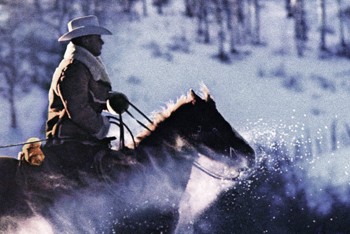
I so wish I was in town for this:
July 28th, 5-8PM, Eric Doeringer, Cowboy Photography Workshop
Artist Eric Doeringer will bring vintage Marlboro advertisements from his collection and will assist participants in re-photographing them in the manner of Richard Prince. Visitors will leave with a high resolution digital file and information on how to have it printed at a large size. Participants are welcome to drop in anytime during the workshop. There will be a small materials fee.
Just another day in the life of HELP/LESS, Chris Habib’s amazing show at Printed Matter.
Doeringer has searched out original copies of the Marlboro ads Prince began rephotographing in 1980, and began his own re-creation? re-enactment? re-performance? of Prince’s Untitled (Cowboy) photos last year.
After the jump, I’ve transcribed a section from Prince’s court deposition where he discusses his early rephotography process:
Continue reading “Cowboy Photography Workshop By Eric Doeringer”
On The Catalogues Of Giants
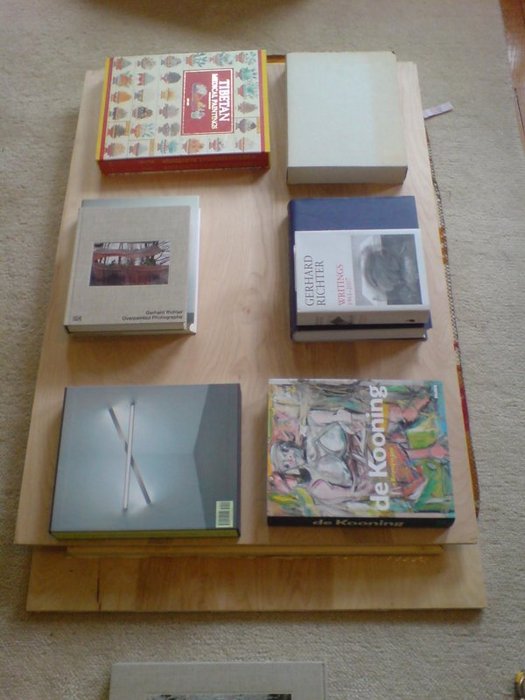
top right is Bonnefoy’s beautiful but otherwise ridiculous Giacometti, and center left is Gober’s Sculptures and Installations, which turned out to be lighter than it looked.
So yeah, hmm, I probably should have glued up the braces on the back of this panel before gessoing it. Well, they’re on there now!
And since they’re set in a bit, my clamps won’t work, and they might mar the surface anyway, so blanket on carpet to cushion the facture, board on glue, the weight of Art History on the board. And I still end up standing on it.
I have to remind myself this is still way more information than I ever got in advance about a painting.
Previous fun with art books: 2002: Rem Koolhaas book under a Wade Guyton table sculpture
Dutch Camo Landscape Painting Painting – 2
Another Sunday painting. Or another Sunday spent painting.
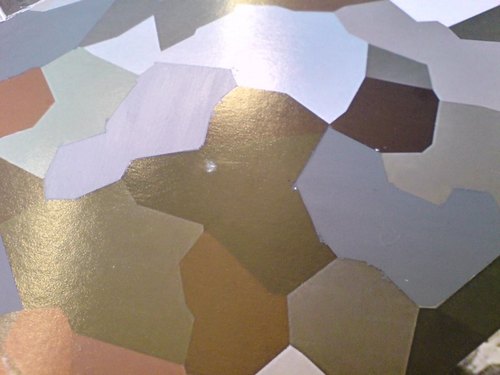
I did another round of taping off and painting on the Dutch Camo Landscape photo of Noordwijk today. The first time, I did two identical gray polygons This time, I did three, with different greys.
The taping is the most time-consuming aspect of the process, the mixing the most uncertain, and the painting itself the most anti-climactic.
Not really knowing anything about color systems or theory, I’m just eyeballing each match. At the moment, there’s something going on, I think, with the way the polys get grouped; I mix one grey, then change it for the next, and then the next. They end up being sequential in a way, related to each other, composed of the same constituent pigments. Until they’re not; the last poly was turning out to be not just lighter, but pinker, redder, and so I gambled and added a new paint, a single drop of red oxide, which blew the whole thing. It eventually came around, though.
Though I’m clearly counting on it somehow, I don’t know what’ll happen when I try to paint next to an already-painted polygon. I mean, on the one hand, I don’t know how paint will handle the tape. On the other, there’s a ridge there now. So I could just paint up to it. But that’d mean some edges will be taped and crisp, and others will be brushed.
At this point, I guess I’m still seeing if paint actually does what I think it’ll do when I do it.
In unrelated news, that brown poly in the center of the photo looks kind of like Iraq.
Creative Time And The Afro-Icelandic Liberation Front

Danish artist Jacob Boeskov flew to Lagos, Nigeria to make and star in a short action film he wrote titled, Dr. Cruel and the Afro-Icelandic Liberation Front with the noted Nollywood director Teco Benson. The film was produced by Creative Time Global, a new series of international initiatives launched this year by the NY public art organization.
Nollywood is known for its vibrant, near-zero-budget film industry, which should probably be called a video feature industry, since HD, DV, and even phonecams are the norm, and everything goes straight to the street on DVD. Dr. Cruel premiered in May in New York, but Creative Time recently posted Boeskov’s production diary online:
It has been a long day and Teco has surely delivered. He really is the finest action director in Nollywood. We have filmed chases and fights. I have destroyed a pair of my pants in one of my amazing stunt moves. He has been great to work with. He has an ability to make actors and crew feel good, even when he shouts at them. But it is late now and everybody is tired.
Just as we’re wrapping up a scene, I hear the sound of a generator dying and the room goes black. The production manager runs down to the street to look for black market fuel. There is a fuel crisis in Nigeria because of the absence of the president and… well, it’s a long story.
I go to the window and light a cigarette. The room is dark, lit only by the cell phones from the actors and the crew. The mood in the room is intense, but okay, I guess. People talk low, or are silent. The production manager is back, looking triumphant. He has managed to buy some fuel in the street, and the generator is running again. The lights are turned on. Back to work.
It all sounds a little crazy, but interesting. Here’s the trailer:
Dr. Cruel and the Afro-Icelandic Liberation Front [creativetime.org via @annepasternak]
What’s Happening? Nina Burleigh Takes On Claes Oldenburg
In her 1998 biography of Mary Pinchot Meyer, Nina Burleigh used Stars, Claes Oldenburg’s Happening at the Washington Gallery of Modern Art’s 1963 Pop Art Festival, as a bellwether for sophisticated Georgetown/Washington’s temperament towards contemporary art. Here’s how Burleigh described the event [from p. 202]:
Stars: A Farce for Objects Designed by Claes Oldenburg and involving twenty-one players, the happening lampooned official Washington and satirized the capital’s iconography. One pieces was a huge sewn miniature of the Washington Monument moving around by means of seven people huddled inside. One scene involved a very well-endowed naked woman coming down some steps, and included such absurdities as a roller skater, a waiter carrying a tray and spilling colored foam rubber bits, a girl brushing her teeth, two men spraying room deodorant, a woman undulating inside two mattresses, a girl ironing, and a child dishing out blue frosting. It was accompanied by drumbeats and a rendition of “Sweet Leilani.” Each action was repeated twenty-four times. It was received with annoyance by the art critic for the Washington Evening Star, who found the whole evening tedious. The show, he wrote, “will be repeated and repeated and repeated tonight.”
Enzo Mari x Ikea Mashup, Being Mashed Up
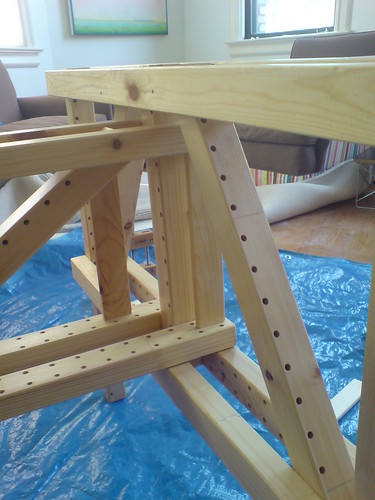
ikea x Mari mashup being mashed up, originally uploaded by gregorg.
I realized I’d been putting off the actual assembly of my Enzo Mari table, daunted by the impending exactitude and fearful of the commitment of actually screwing all the pieces together.
Which seems to fly in the face of Mari’s original “just hammer it together” intentions for the autoprogettazione series.
I knew that without jigs and a flat surface and proper squaring equipment and such, I was invariably going to misdrill something, and then I’d be trying to redrill holes 1/8th of an inch to the left somewhere, and–
The joint that really made me nervous was the first one I’d have to do, drilling a 5/16″ hold through the center of all the side truss pieces [right about where the knot is in this photo] AND through the ends of the center truss, so that I could thread a carriage bolt through, and hold the entire table together properly. Forever.
Rather than risk screwing this up, I decided to piece each truss together with a steel bookend, and then hammer and wood glue enough joints to hold it. Then I’ll drill and screw the major joints after it’s together.
The carriage bolt and wingnut assembly method is a nod to the original autoprogettazione kits of precut wood, which were produced in 1973 by Simon International and sold briefly as the Metamobile Series.
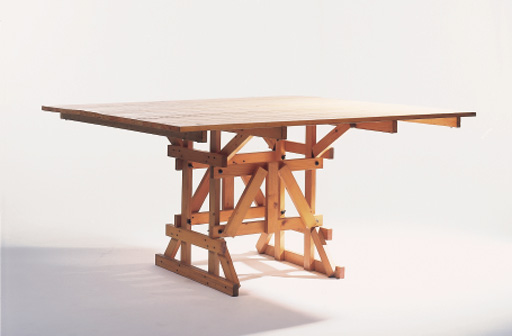
I hadn’t thought of how much those simple wingnuts changed the nature of the autoprogettazione concept. They’re the difference between project and product.
The Metamobile kits weren’t just precut wood; they were also predrilled. And that required the construction of jigs, the use of some workshop- or factory-grade hardware, and probably even an assembly line, or at least some batch work. In other words, they were exactly what the autoprogettazione series was supposed to not be: mass produced.
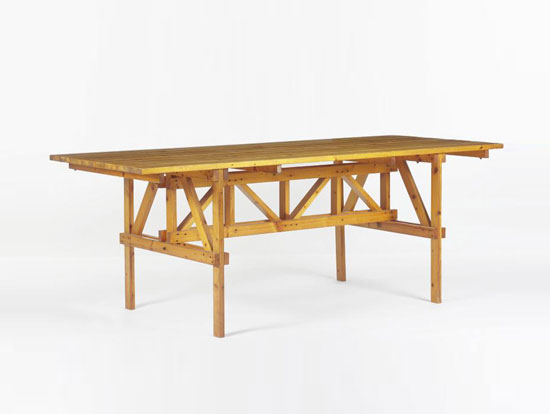
Furniture sold as a kit of parts that comes ready to assemble, with just one tool, just follow the slightly baffling instruction diagrams exactly, and voila! Sound familiar? Enzo Mari beat me to an Ikea mashup by about 35 years.
Related: 14 June 2000, Lot 103: ENZO MARI, A PINE DINING TABLE
“designed 1973, manufactured by Simon International for the Metamobile Series, the square slatted top on open understructure secured by wing-nuts”, sold for £5,875. [christies.com]
Dec 15, 2006, Lot 2: ENZO MARI, AN EXTREMELY RARE “EFFE” TABLE
“Manufactured by Simon International, ca. 1974. from the Metamobile series…Acquired directly from Dino Gavina, c. 1975,” sold for $14,400 [sothebys.com]
NYT Reviews the Sony HDRFX1 High Def Camera
 In the NY Times today, David Pogue reviews Sony’s new prosumer (i.e., sub-$4,000) 3-chip, high definition camera, the FX1. Net net, it gets pretty high marks. It’s got a stunning, true 16:9 CCD, which can shoot HD30 or film’s 24 frames per second. One feature I’m eager to see in person is the pre-programmable settings with which you can automate changes in exposure and focus to match the changes in a shot–moving from a bright exterior to a dimly lit interior, for example.
In the NY Times today, David Pogue reviews Sony’s new prosumer (i.e., sub-$4,000) 3-chip, high definition camera, the FX1. Net net, it gets pretty high marks. It’s got a stunning, true 16:9 CCD, which can shoot HD30 or film’s 24 frames per second. One feature I’m eager to see in person is the pre-programmable settings with which you can automate changes in exposure and focus to match the changes in a shot–moving from a bright exterior to a dimly lit interior, for example.
Eeven so, it’s still saddled with one of Sony’s persistently annoying dumb-downs–no XLR sound inputs–meant only to protect the far more expensive professional market. They did this with their first 3-chip camera, the VX1000 as well, making people use add-on XLR adaptors until the PD-150 was introduced several years later.
Anyway, if you think you’re ready to shoot HD, the FX1 is for sale at Amazon. I’m probably not supposed to tell you the price, but I will say that if Amazon paid me a 10% commission–which they won’t–I’d earn $334 off of each one of you budding, shopping filmmakers.
Buy the Sony HDRFX1 High Def Camera at Amazon
Home Video Made To Watch on High Definition TV [NYT]
The Sound of One Hand Clapping Over Your Mouth
It is about this time that we realized we were in a room of fundamentalist film students, for they were laughing appreciatively with the person in the position to one day give them work, and sneering at the representative of a free press. In short, they are fully prepared for Hollywood.
– bwahahaha, Fox Searchlight gets all Rathered up, planting (aka “inviting”) a NYT’s gossip reporter [sic] in a Columbia U. screening and Q&A where my boy, David O. Russell, worked the crowd into a frenzy against her by criticizing Sharon Waxman’s leg-humping I Heart Huckabees article.
Hey Pal, Where’s the Lousy Compassion? [Boldface Names, NYT]
The Nudist Buddhist &c., &c. [greg.org]
The Nudist Buddhist, or Humping Sharon Waxman’s Leg
Whatever it takes to get the story, I guess. A serious shoutout to the Times’ Sharon Waxman, who had my boy David O. Russell [boxers, not that anyone asked] rub up against her on the set of I Heart Huckabee’s.
That’s the tip of the antics iceberg, though. Check out Waxman’s report covering the last 18 months of the production.
Interestingly, she’s very cagey about the finished product itself. She was very circumspect on the reactions at a cast/family/friends screening. Meanwhile, the film seems to be rocking ’em in Toronto.
The Nudist Buddhist Borderline-Abusive Love-In [Sharon Waxman, NYT]
Tom Hall ♥’s I ♥ H [Indiewire, via Greencine]
[9/22 Update: Defamer reports [sic] that D.O. is P.O.’ed about Waxman’s NYT article; seems he thought she was writing a book. Which, technically, is true. It’s called Rebels on the Backlot: Six Maverick Directors and How They Conquered the Hollywood Studio System.]
Kevin Smith Production Diary for Jersey Girls

On his illustrious entertainment portal Movie Poop Shoot, Kevin Smith is publishing a weekly production diary of Jersey Girls, his latest, which he calls “hands-down, the best movie we’ve ever made.” The dates are a little ambiguous. The Week One entry is dated July 12, and the Week Two entry isn’t exactly dated, but the original schedule had the 11-week shoot wrapping on November 1, er, tomorrow. It’s got Ben Affleck and Jen Lopez in it, who also star in the unofficial off-the-set production diary, E! Online. Bonus: There’s a big show tunes musical number in it.
Since the eerie gap in this online production diary overlaps perfectly with the lag on Full Frontal (where it was Week 3 for two+ months), my theory is Miramax had some kind of summer web embargo, or fired their sysadmin and couldn’t do updates, or something.
Well, early to rise, at least

Joseph Smith Sphinx, Gilgal Garden, Salt Lake City [image via pjf]
Unable to stay asleep, I read Paul Ford’s excerpt of Benjamin Franklin’s autobiography, wherein I learn that Franklin’s worth more than a Benjamin. At age 79, he recounts his clearheaded pursuit of Moral Perfection, determining that:
on the whole, tho’ I never arrived at the perfection I had been so ambitious of obtaining, but fell far short of it, yet I was, by the endeavor, a better and a happier man than I otherwise should have been if I had not attempted it; as those who aim at perfect writing by imitating the engraved copies, though they never reach the wished-for excellence of those copies, their hand is mended by the endeavor, and is tolerable while it continues fair and legible.
Since it’s much more fun to get (morally) high together, I invite you all to listen in to the semi-annual General Conference of The Church of Jesus Christ of Latter-Day Saints which takes place this weekend. A well-spoken crop of 79-year olds (give or take a few years) will be imparting the Word from The Pulpit.
This in turn brought to mind the shiny corporate newness of the giant conference center that recently usurped the more famous Tabernacle as the official seat of the Conference. And for a moment, I was sad to see only one Google citation of my preferred name for the center, the Meganacle.
And which kindred wordsmith, laboring alone until now to propagate this term, accurately points out the building’s resemblance to ancient Babylon or “government buildings constructed during Franco’s era in Madrid?” Terry Tempest Williams, who’s more Word Whisperer than wordsmith, I guess.
Lacking a serene slate terrace and a morning dew-covered chair from which to watch the fawns scamper, I’ve never read TTW’s books. (Although they sure love her over on the NPR.) But this essay–which includes an interesting story of visiting her ancestors’ graves and “sharing genealogies, a typical Utah pastime,” with fellow cemeterygoers–also gives a great deal of attention to Gilgal Garden, a brilliant and unusual work of Mormon artistic expression I’d always thought we weren’t supposed to talk about. See more photos and the original brochure.
How Kevin Smith may be the Most Important Filmmaker on The Internet
Kevin Smith‘s irreverent but brilliant Dogma just ended on Comedy Central (albeit in highly edited form). I sat behind Smith and his posse when it premiered at the 1999 NY Film Festival, but I haven’t seen it since. It really is great–a serious exploration of real issues of faith in an unexpected way (and by an under-the-radar believer). Smith is certainly an influence in terms of his career and his smart use of the net–via his View Askew site–to connect with his audience, if not in his actual films. Don’t get me wrong; I love his movies, but I haven’t really studied them. Here is Kevin’s online production diary from Dogma. Begun in March 1998, it’s the earliest moviemaking “weblog” I’ve found.

